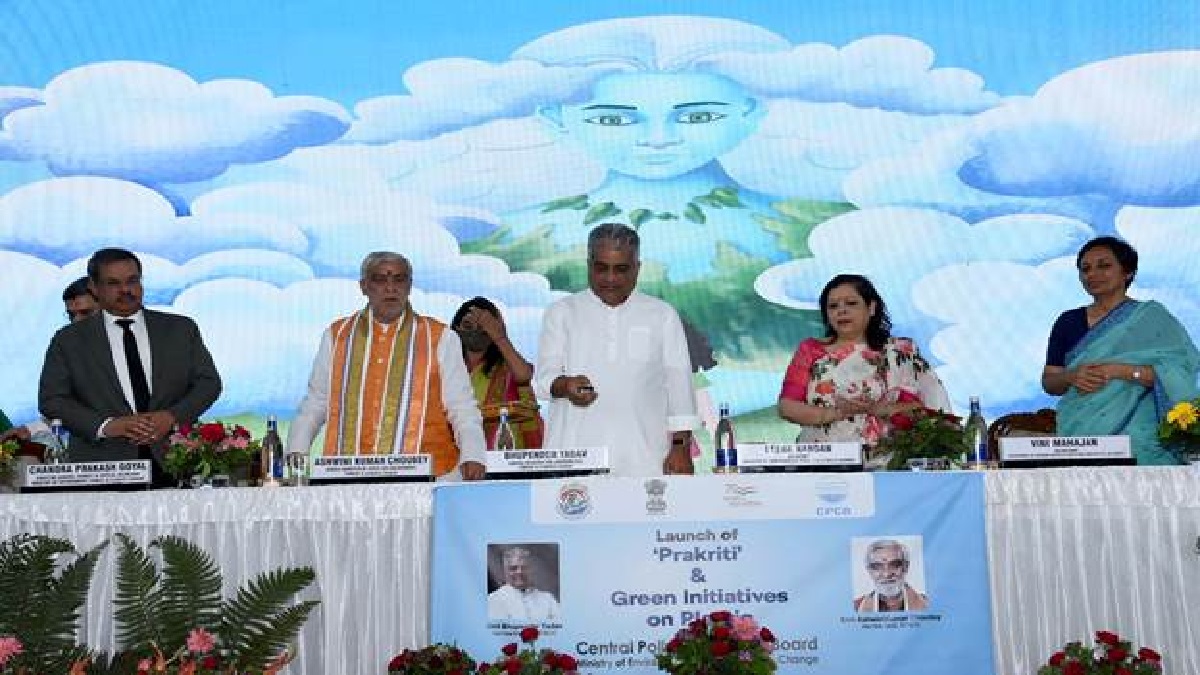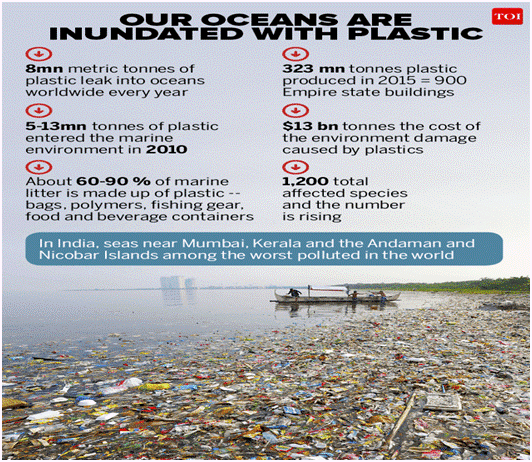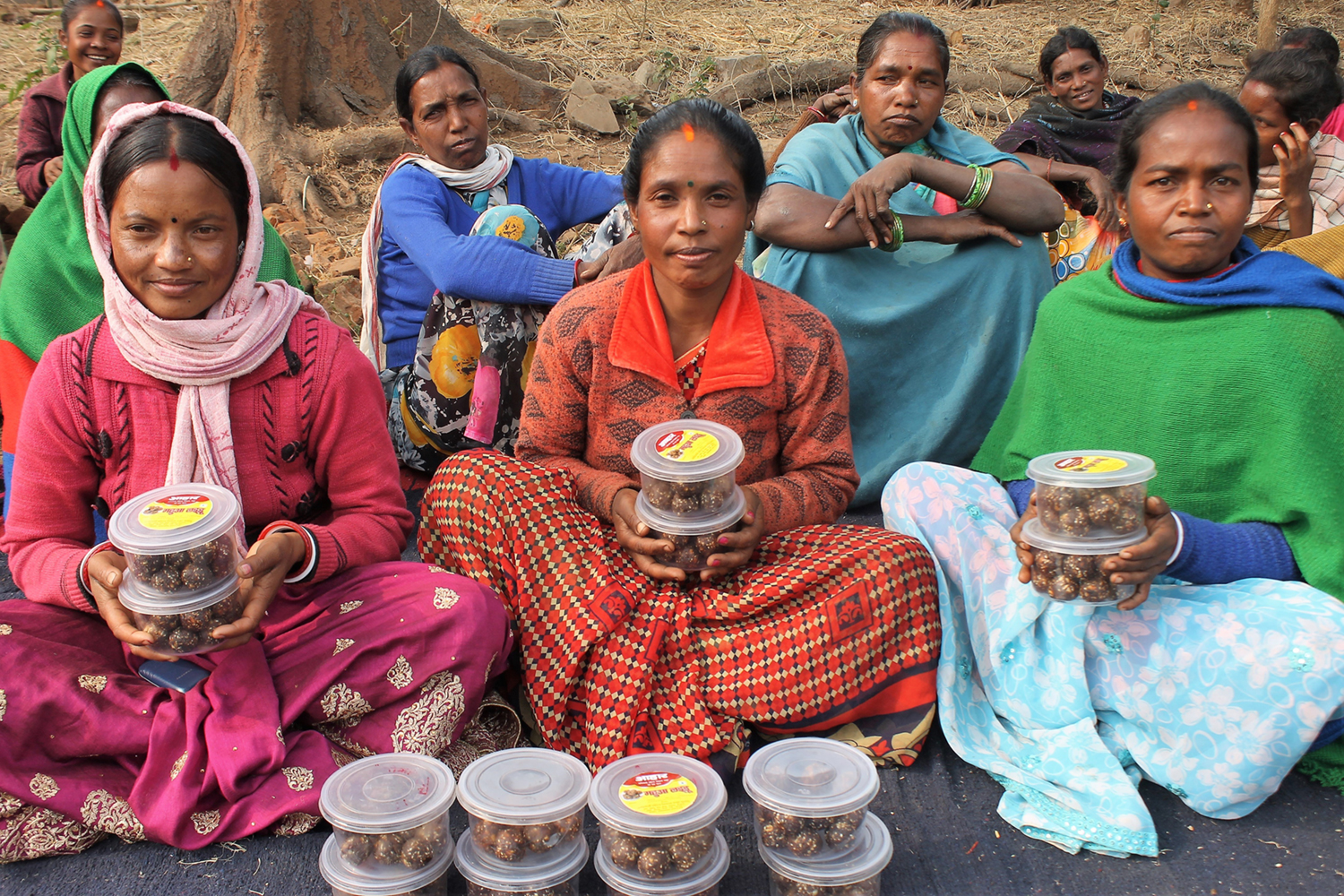Description

Copyright infringement is not intended
Context: The Union Minister of Environment, Forest & Climate Change, launched ‘Prakriti’, a mascotto spread greater awareness among masses about small changes that can be sustainably adopt in our lifestyle for a better environment, and various green initiatives taken by Ministry of Environment, Forest & Climate Change and Central Pollution Control Board (CPCB) to ensure effective Plastic Waste Management (PWM) in the country.
Need to take these measures:
- To tackle the challenge of plastic pollution, India took pledge to phase out Single Use Plastics (SUPs) by 2022.
- India is generating about 5 Million Tonnes of plastic waste annually and the per capita plastic waste generation has almost doubled over the last five years.
- Plastic Pollution adversely affects our ecosystems and is also linked to air pollution.
- Recently released IPCC Working Group III contribution to the IPCC Sixth Assessment Report (AR6), which focuses on mitigation measures to keep the world aligned to the Plastic Waste Management goals.
New green initiatives launched for plastic waste management:
- National Dashboard on Elimination of Single Use Plastic and Plastic Waste Management (MoEFCC) to bring all stakeholders including Central Ministries/ Departments, State/UT Governments at one place and track the progress made for elimination of single use plastic (SUP) and effective management of plastic waste.
- Extended Producer Responsibility (EPR) Portal for Plastic Packaging(CPCB) for improving accountability, traceability, transparency and facilitating ease of reporting compliance to EPR Obligations by Producers, Importers and Brand-owners
- Mobile App for Single Use Plastics Grievance Redressal(CPCB) to empower citizens to check sale/usage/manufacturing of SUP in their area and tackle the plastic menace.
- Monitoring module for SUP (CPCB), for local bodies, SPCBs/PCCs and CPCB, to inventorize details of SUP production/ sale & usage in commercial establishments at district level, and on-ground enforcement of ban on SUP.
- Industrial production of Graphene from Waste Plastic(G B Pant NIHE & NRDC) to promote more industries to come forward to up cycle plastic waste
What is Plastic Pollution?
- Plastic pollution occurs when plastic has gathered in an area and has begun to negatively impact the natural environment and create problems for plants, wildlife, and even the human population.
- This includes killing plant life and posing dangers to local animals.
- Plastic is an incredibly useful material, but it is not biodegradable.
Various Causes of Plastic Pollution:
- As plastic is less expensive, it is one of the most widely available and overused items in the world today.
- Rapid urbanization and population growth increase the demand of cheap plastics.
- Since it is an affordable and durable material, it is utilized in every other way possible, from packaging materials to plastic bottles and containers, straws to plastic carry bags.
- Plastic takes 400 years and even more to Decompose. The decomposition rate of plastic typically ranges from 500 to 600 years, depending on the type.
- Abandoned Fishing Nets
- Disposal of plastic is often mismanaged; it ends up in landfills.
- Burning plastic is incredibly toxic and can lead to harmful atmospheric conditions and deadly illnesses.
Serious Effects of Plastic Pollution:
- Negative Effects on Human Health: Microplastics entering the human body via direct exposures through ingestion or inhalation can lead to an array of health impacts, including inflammation, genotoxicity, oxidative stress, apoptosis, and necrosis, which are linked to an array of negative health outcomes including cancer, cardiovascular diseases.
- Plastic-contaminated seafood: Scientists have found micro plastics in 114 marine species, and around one-third of these end up on our plates.
- Upsets the Food Chain: Because it comes in sizes large and small, polluting plastics even affect the world’s tiniest organisms, such as plankton.
- Groundwater Pollution: Most of the litter and pollution affecting the world’s oceans and groundwater comes from plastics.
- Land Pollution: When plastic is dumped in landfills, it interacts with water and forms hazardous chemicals. When these chemicals seep underground, they degrade the water quality. The wind carries and deposits plastic from one place to another, increasing the land litter.
- Air Pollution: Burning of plastic in the open air leads to environmental pollution due to the release of poisonous chemicals.
- Economic impacts: Plastic pollution costs $13 billion in economic damageto marine ecosystems per year. This includes losses to the fishing industry and tourism, as well as the cost to clean up beaches. Economic costs include those linked to clean-up operations, litter removal, the repair and replacement of damaged vessels and gear, reduced fishing catches, and a decline in coastal tourism and impact on related industries.
- Marine life: The most visible and disturbing impacts of marine plastics are the ingestion, suffocation and entanglement of hundreds of marine species. Marine wildlife such as seabirds, whales, fishes and turtles, mistake plastic waste for prey, and most die of starvation as their stomachs are filled with plastic debris.
|
Plastic Waste Management Rules, 2016
· It aims to increase minimum thickness of plastic carry bags from 40 to 50 microns.
· Expand the jurisdiction of applicability from the municipal area to rural areas, because plastic has reached rural areas also.
· Extended Producer Responsibility: To bring in the responsibilities of producers and generators, both in plastic waste management system and to introduce collect back system of plastic waste by the producers/brand owners, as per extended producers responsibility
· Introduced collection of plastic waste managementfee through pre-registration of the producers, importers of plastic carry bags/multilayered packaging and vendors selling the same for establishing the waste management system
· Promote use of plastic waste for road construction as per Indian Road Congress guidelines or energy recovery, or waste to oil etc. for gainful utilization of waste and also address the waste disposal issue.
|

Copyright infringement is not intended
What are microplastics?
- Microplastics are plastic debris smaller than 5mm in length, or about the size of a sesame seed.
- They come from a variety of sources, one of them is when larger pieces of plastic degrade into smaller pieces, which are difficult to detect.
Why is microplastic pollution especially harmful?
- The durability of plastic, which implies that plastic can take hundreds to thousands of years to decompose depending on the type of plastic and where it has been dumped.
- In the oceans, plastic pollution impacts marine life, ocean health, coastal tourism and even human health.
- Over the past few years, various news reports have shown that marine animals such as whales, seabirds and turtles unknowingly ingest plastic and often suffocate.
- For humans, too, marine plastic pollution is harmful if it reaches the food chain. For instance, microplastics have been found in tap water, beer and even salt.
- One of the first studies to estimate plastic pollution in human ingestion that was published in June 2019 said that an average person eats at least 50,000 particles of microplastic each year.
Measures taken by government:
- India has pledged to ban all single-use plastics by 2022.
- All offices of central and state governments and major PSUs have been told to prohibit single-use plastic products.
- India has banned imports of solid plastic waste.
- India has passed the Plastic Waste Management Rules, 2016 and introduced the Extended Producer Responsibility.
Way Forward:
The 3R’s +E Strategy:
- Reduce: To efficiently reduce plastic pollution, there is an evident need of reducing our usage of plastic.
- Reuse: Many plastic items can be reused or used for different purposes. Before throwing plastic items, it is important to consider how they can be reused.
- Recycle: Plastic recycling consists of collecting plastic waste and reprocessing it into new products, to reduce the amount of plastic in the waste stream.
- Educate: Another crucial solution is education in order to increase awareness and behavioral change.
Legal wayout:
- Law can be framedand used to tackle plastic pollution and support a circular plastics economy.
- Policy shiftscan reduce plastic pollution by incentivizing changes in both business and consumer behavior, as well as in plastic design, alternatives and recycling.
- Governments can also impose taxesto deter the production or use of single-use plastics, or offer tax breaks, subsidies and other fiscal incentives to encourage alternatives to single-use plastic products.
- Product standards, certifications and labeling requirements can be designed to educate the public on the environmental impacts of plastic, and on the health and safety hazards involved in their production and use.
- Extended Producer Responsibility (EPR) programscan ensure that manufacturers maintain responsibility for single-use plastic products throughout the whole life cycles of those products.
Conclusion:
- There is no silver bullet to solving the world's plastic problem. It will require governments at both the national and sub-national levels to tackle the regulation of single-use plastic products, determining what policy approaches they want to use and what type of legislation will support their objectives.
https://pib.gov.in/PressReleasePage.aspx?PRID=1813806











